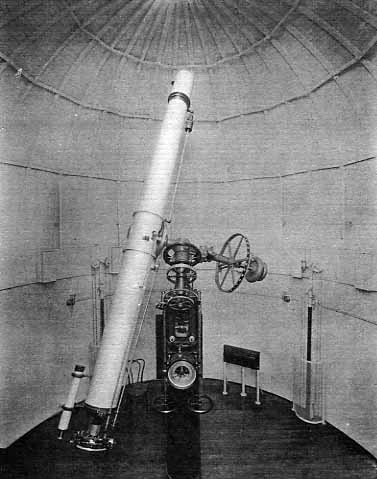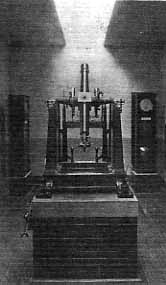The Story of My Life - George Nicholas Saegmuller
Back
•
Up
•
Next
Article written for Bausch & Lomb's The Reflector
[The Reflector seems to be a Bausch & Lomb internal newsletter – DFB]
THE REFLECTOR
May, 1920, pages 4 and 5
The Bausch & Lomb Observatory
By George N. Saegmuller
Mr Saegmuller has given us this article to tell us
something about our observatory and, in general, awaken an interest in
astronomy. Astronomy is the oldest of sciences, having been handed down from the
early Oriental shepherds, who gazed at the heavens with the naked eye, to the
present day when giant observatories dot the world and powerful lenses reveal
distant celestial secrets.
 |
Our 11-inch Refractor
11-inch Refractor of the Bausch & Lomb Optical Company
Observatory for the study of the sky and celestial phenomena equipped
with Geo. N. Saegmuller's "Star dials" electrically controlled clock
drive and a position micrometer for most accurate research work.
|
This observatory is now erected on top of Building No. 16,
having been moved from its former site on Huntington Park. The new location
commands nearly the entire horizon and is far superior to its former one.
The main instrument of the observatory is an equatorially mounted telescope with
a Zeiss objective of 11-inch aperture and of a little more than 16-foot focal
length. It is mounted on a heavy iron column resting on one of the columns of
the building, the latter extending from the ground to the roof. This column
carries the headstock on which is mounted the moving parts. These are carried by
the polar axis, a rigid steel shaft which points to the North Pole, carrying, at
right angles to it, another axis, called the declination axis, to which the
telescope is secured, also at right angles. Both axes can be moved independently
of each other; the polar axis can be turned to follow the apparent diurnal
motion of the stars, and the declination axis can be moved from pole to equator.
Thus by moving these two axes, the telescope can be pointed to any part of the
heavens.
The position of any star is determined by its Right Ascension and Declination,
which can be found in any star catalogue. Right Ascension and Declination on the
celestial sphere correspond to longitude and latitude on the earth's surface.
In order to be able to point the telescope according to those
co-ordinates, both axes are provided with graduated circles, the polar axis
carrying the hour circle and the declination axis one giving the declinations
numbered in four quadrants.
These circles are really not needed to find a star, as the
mounting is provided with the "Star Dials," invented by our Mr. George N.
Saegmuller in 1888, and first applied to the 12-inch Georgetown Equatorial. The
chief advantage of these "Star Dials" consists not only in the ease with which
both Right Ascension and Declination Circles can be set and read, as these dials
are located at a convenient height from the floor, but also that the hour angle
does not have to be computed. This is accomplished by the hour circle of the
"Star Dials" being rotated continuously by a special clock movement conforming
to the diurnal motion of the earth.
When it is considered that with large size telescopes the
circles are located from 10 to 15 feet above the floor, and that ladders have to
be used in order to read them —unless cumbersome and complicated optical devices
are used to read them from the floor— the great convenience of these Star Dials
cannot be over-estimated. All large equatorials are now provided with them.
The settling of the telescope is accomplished
by moving it by means of two hand wheels, conveniently arranged below the "Star
Dials," which communicate the motion to both axes, and at the same time rotate
the dials where two pointers sweep over the circles. These circles and the
auxiliary clock are encased in a circular box attached to the south side of the
column.
In order to avoid the necessity of moving the telescope by
hand in following a star, a powerful clock, located on the top of the column, is
connected with the polar axis and moves the telescope so uniformly that a star
once in the field will remain there for hours. The movement is regulated by a
centrifugal governor controlled by the standard sidereal clock of the
observatory. Provision is made for changing the rate of the clock from sidereal
to lunar in a few moments. Although the telescope and its moving parts weigh in
the neighborhood of 2,000 pounds, it is so nicely counterbalanced that it will
move with the touch of the little finger.
When observing near the Zenith, the telescope points
vertically upward, and the eye end is at the lowest position. When observing
near the horizon, the telescope is horizontal and the eye end at its highest
position, this difference in height amounting to about 7 feet. In order to give
the observer a convenient position without making use of the old style observing
ladders, the observatory floor is made to move up and down by means of an
electric motor which actuates four screws fitting into corresponding nuts
attached to the floor. The rotating dome with its movable shutter can also be
moved electrically.
 |
Transit Instrument
Transit instrument for the determination of accurate
time and latitude. The telescope of three inch aperture is equipped with
an automatic recording eyepiece micrometer. The mean time clock is to
the left, and sidereal time clock to the right
|
The next important instrument is the Transit Instrument, by
means of which the correct time is obtained. It is located in a room near the
equatorial room on a pier isolated from the floor. It has a telescope of 3-inch
aperture and a focal length of 45 inches; this is secured at right angles to an
axis, resting in Y's, which are secured to the heavy iron stand and lie in an
east and west line. Thus the telescope can only be moved in a north and south
direction; that is, it sweeps the meridian.
The transits of stars are observed by noting when they pass a
series of fine lines, when the exact time is noted. If the observed time is
exactly Oh, Om and Os, when the first point of Aries passes the meridian, the
sidereal clock is correct.
The instrument is also arranged for accurate latitude
observations, and for this purpose a reversing apparatus is supplied by means of
which the telescope can easily be reversed 130° in order to eliminate
collimation errors and be able to observe north and south stars at the time of
their culmination.
For accurate time observations another instrument is used—the
Chronograph. This consists primarily of a clockwork, rotating cylinder covered
with paper, on which the sidereal clock marks every second. As the observer is
enabled by the mere pressing of a button to make a mark on the paper, a
comparison of the clock mark and the observer's mark will give the exact time
when the notation by the observer was made. Thus the time is graphically
recorded and can be read to the nearest 1/100 of a second.
The Sidereal Clock is the standard clock of the observatory,
and its rate can be depended upon within a fraction of a second.
The Mean Time Clock is regulated by the Sidereal Clock.
Altogether the equipment of the observatory is of the highest
class and fitted for the most accurate kind of research work, some of which, it
is expected, will be started some day. It will also be available for popular use
in viewing the interesting celestial phenomena.
Heavens Hold No Secrets from Observatory
Our Folks To Have Chance To Look at Luna's Unrouged Face.
In this issue Mr. Saegmuller tells us about
the wonderful instruments (made in our own plant and by our own people) that the
company has set up in our midst. Everyone has noticed the dome that caps the
north end of Building 16 and wondered what was inside. We have now been told
about the instruments it houses and their uses, but it is not to stop there.
The company proposes to arrange so that individuals can go up
into the observatory and, through its instruments, search out the secrets of the
heavens and get a "closeup" of the man in the moon. As soon as these
arrangements have been completed, details will be given out.
"All aboard for Luna!"
Back
•
Up
•
Next

